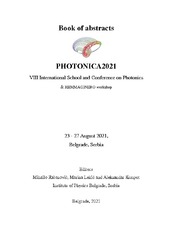Приказ основних података о документу
Laser microsurgery of filamentous fungi: The latest protocol enabling patch-clamp amenable protoplasts
| dc.contributor | Rabasović, Mihailo D. | |
| dc.contributor | Lekić, Marina | |
| dc.contributor | Krmpot, Aleksandar J. | |
| dc.creator | Stevanović, Katarina | |
| dc.creator | Pajić, Tanja | |
| dc.creator | Todorović, Nataša | |
| dc.creator | Krmpot, Aleksandar J. | |
| dc.creator | Živić, Miroslav | |
| dc.creator | Rabasović, Mihailo D. | |
| dc.date.accessioned | 2022-01-17T13:54:54Z | |
| dc.date.available | 2022-01-17T13:54:54Z | |
| dc.date.issued | 2021 | |
| dc.identifier.isbn | 978-86-82441-53-3 | |
| dc.identifier.uri | http://radar.ibiss.bg.ac.rs/handle/123456789/4714 | |
| dc.description.abstract | We have developed an advanced protocol for laser cell surgery to obtain protoplasts of filamentous fungi, suitable for investigation of ion channels, relying on few attempts already made in the past. Among obtained protoplasts, 32% were shown to be “patchable”, meaning that formation of the gigaseal by the micropipette was possible. Protoplasts were produced by first making an incision on the cell wall of plasmolysed hyphae by a tightly focused femtosecond laser beam. Cell surgery is followed by a reduction of solution osmolarity to promote extrusion of protoplast (or more often, a part of it) through the cut. The two key points- cell surgery parameters and the proper sequence of the solutions used – were subjected to variations to gain insight into parameters that contribute to protoplast production and stability. The proper selection of the pipette size and shape with respect to the protoplast size was also of great importance. Cell surgery and hyphae imaging was performed by a nonlinear laser scanning microscope. Ti:Sa laser was operating at 730nm, with 76MHz repetition rate and 160fs pulse duration. Water dipping objective lens (40 x 1.0, Zeiss W Plan-Apochromat) on the upright non-linear microscope system made possible to perform laser surgery and patch clamp on two separate systems, while working in the same microscopic chamber. Prior to microsurgery, two-photon excitation fluorescence was used to scan the hyphae cell wall stained with Calcofluor white dye, using the same wavelength as for the surgery. Two-step plasmolysis, with increased concentration of calcium in the more hyperosmotic solution was both efficient for microsurgery to be performed and had a stabilizing effect on protoplasts. Subtle deplasmolysis prior to the patch clamping effective enough to stimulate protoplasts to exit, without making the membrane overstretched to interact with the pipette was employed. Optimized concentration and type of chemical agens for inhibition of the cell wall production was continuously present in all solutions, as an indispensable factor for success. | sr |
| dc.language.iso | en | sr |
| dc.publisher | Belgrade : Institute of Physics | sr |
| dc.relation | Project „Minimally invasive, selective ablation of dental caries by femtosecond laser “, Move for the science/2019. | sr |
| dc.relation | info:eu-repo/grantAgreement/ScienceFundRS/Promis/6066079/RS// | sr |
| dc.rights | openAccess | sr |
| dc.source | VIII International School and Conference on Photonics PHOTONICA2021 & HEMMAGINERO workshop | sr |
| dc.title | Laser microsurgery of filamentous fungi: The latest protocol enabling patch-clamp amenable protoplasts | sr |
| dc.type | conferenceObject | sr |
| dc.rights.license | ARR | sr |
| dc.rights.holder | © 2021 by the Institute of Physics | sr |
| dc.description.other | Rabasović MD, Lekić M, Krmpot AJ, editors. Book of Abstracts: VIII International School and Conference on Photonics & HEMMAGINERO workshop: Photonica2021; 2021 Aug 23-27; Belgrade, Serbia. Belgrade: Institute of Physics; 2021. p. 104. | sr |
| dc.citation.spage | 104 | |
| dc.type.version | publishedVersion | sr |
| dc.identifier.cobiss | 44290057 | |
| dc.identifier.fulltext | https://radar.ibiss.bg.ac.rs/bitstream/id/9629/bitstream_9629.pdf | |
| dc.citation.rank | M34 | |
| dc.identifier.rcub | https://hdl.handle.net/21.15107/rcub_ibiss_4714 |

